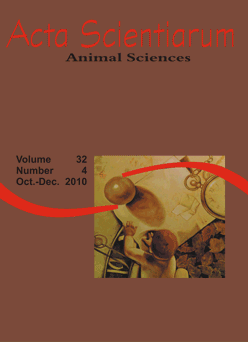<b>Industrial crossbreeds on carcass and meat characteristics of veal heifers</b> - doi: 10.4025/actascianimsci.v32i4.6852
Keywords:
Nelore, Limousin, Red Angus, sarcomere, myofibrillar fragmentation index, shear force
Abstract
The experiment was carried out with the objective of comparing carcass and meat characteristics of 18 heifers from the following industrial crossbreeds: ½ Nelore ½ Limousin (L), ½ Limousin ¼ Red Angus ¼ Nelore (LR), and ⅝ Red Angus ⅜ Nelore (RNR). The heifers were confined at 18 months of age, weighing 280 ± 8.4 kg, during 112 days. After slaughter and carcass cooling, the following traits were evaluated: carcass yield (CY); rib eye area (REA); cushion thickness (CT); fat thickness (FT); carcass length (CL) and leg length (LL); muscle, bone and fat percentages. From Longissimus dorsi muscle samples, the following traits were evaluated: proximate composition; pH; water loss; shear force (SF); sarcomere length (SL); myofibril fragmentation index (MFI). The data were submitted to analysis of variance and the means were compared by Tukey’s test at 5% significance. The LR crossbreed showed the best carcass and meat characteristics, with CY=54.72%, CT=27.87 cm, FT=4.53 cm, REA=63.65 cm2, lean meat=64.58%, water loss=26.63%, pH=5.72; SF=2.49 kg, SL=1.91 µm and MFI=83.59.Downloads
Download data is not yet available.
Published
2010-10-22
How to Cite
Souza, V. L. F. de, Ayer, I. M., Gasparino, E., Cardozo, R. M., Barbosa, M. J. B., & Saddi, L. G. do C. (2010). <b>Industrial crossbreeds on carcass and meat characteristics of veal heifers</b> - doi: 10.4025/actascianimsci.v32i4.6852. Acta Scientiarum. Animal Sciences, 32(4), 447-453. https://doi.org/10.4025/actascianimsci.v32i4.6852
Issue
Section
Animal Production
DECLARATION OF ORIGINALITY AND COPYRIGHTS
- I Declare that current article is original and has not been submitted for publication, in part or in whole, to any other national or international journal.
The copyrights belong exclusively to the authors. Published content is licensed under Creative Commons Attribution 4.0 (CC BY 4.0) guidelines, which allows sharing (copy and distribution of the material in any medium or format) and adaptation (remix, transform, and build upon the material) for any purpose, even commercially, under the terms of attribution.
Read this link for further information on how to use CC BY 4.0 properly.
0.9
2019CiteScore
29th percentile
Powered by 








































